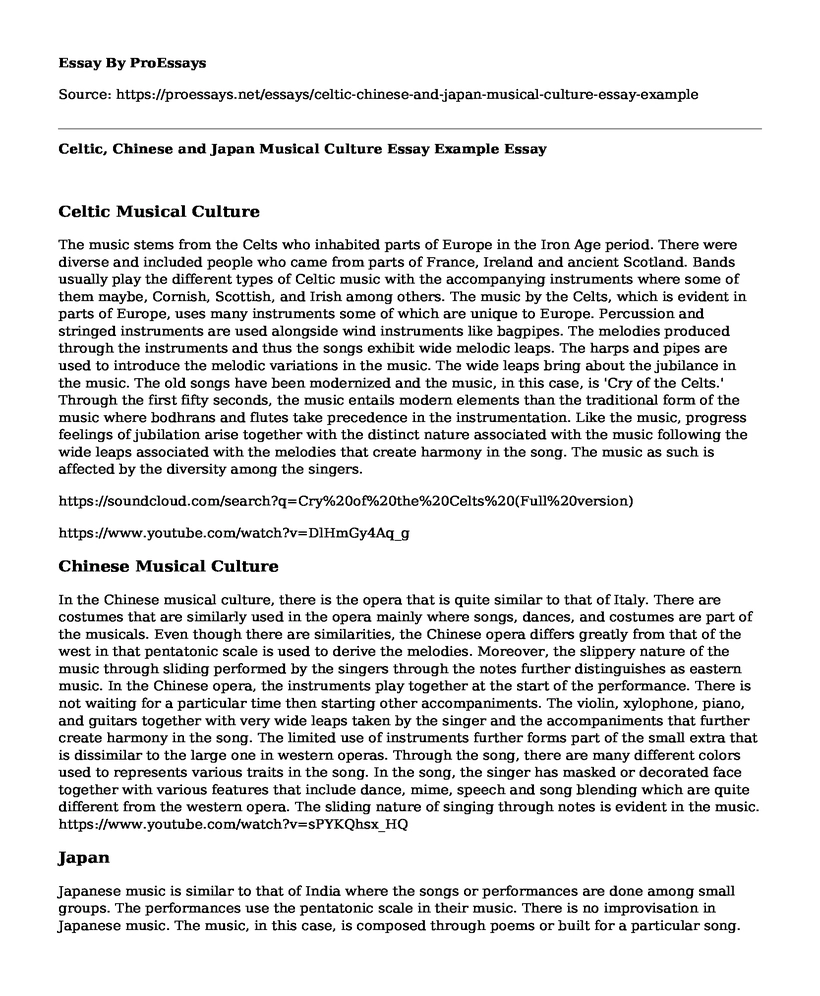Celtic Musical Culture
The music stems from the Celts who inhabited parts of Europe in the Iron Age period. There were diverse and included people who came from parts of France, Ireland and ancient Scotland. Bands usually play the different types of Celtic music with the accompanying instruments where some of them maybe, Cornish, Scottish, and Irish among others. The music by the Celts, which is evident in parts of Europe, uses many instruments some of which are unique to Europe. Percussion and stringed instruments are used alongside wind instruments like bagpipes. The melodies produced through the instruments and thus the songs exhibit wide melodic leaps. The harps and pipes are used to introduce the melodic variations in the music. The wide leaps bring about the jubilance in the music. The old songs have been modernized and the music, in this case, is 'Cry of the Celts.' Through the first fifty seconds, the music entails modern elements than the traditional form of the music where bodhrans and flutes take precedence in the instrumentation. Like the music, progress feelings of jubilation arise together with the distinct nature associated with the music following the wide leaps associated with the melodies that create harmony in the song. The music as such is affected by the diversity among the singers.
https://soundcloud.com/search?q=Cry%20of%20the%20Celts%20(Full%20version)
https://www.youtube.com/watch?v=DlHmGy4Aq_g
Chinese Musical Culture
In the Chinese musical culture, there is the opera that is quite similar to that of Italy. There are costumes that are similarly used in the opera mainly where songs, dances, and costumes are part of the musicals. Even though there are similarities, the Chinese opera differs greatly from that of the west in that pentatonic scale is used to derive the melodies. Moreover, the slippery nature of the music through sliding performed by the singers through the notes further distinguishes as eastern music. In the Chinese opera, the instruments play together at the start of the performance. There is not waiting for a particular time then starting other accompaniments. The violin, xylophone, piano, and guitars together with very wide leaps taken by the singer and the accompaniments that further create harmony in the song. The limited use of instruments further forms part of the small extra that is dissimilar to the large one in western operas. Through the song, there are many different colors used to represents various traits in the song. In the song, the singer has masked or decorated face together with various features that include dance, mime, speech and song blending which are quite different from the western opera. The sliding nature of singing through notes is evident in the music. https://www.youtube.com/watch?v=sPYKQhsx_HQ
Japan
Japanese music is similar to that of India where the songs or performances are done among small groups. The performances use the pentatonic scale in their music. There is no improvisation in Japanese music. The music, in this case, is composed through poems or built for a particular song. Though the rhythms are regular, the harmony is not intended as that of western music. There are no variations in performances as the musicians memorize the different songs and perform them the exact way in every instance. A shakuhachi, which is a flute, is used with the accompaniment of a koto, which is a stringed instrument. Tsuki no Shizuku is a folk song originating in Japan. The song has various instruments accompanying it, which include the koto and shakuhachi. The clear, distinct sound of the koto, which is the stringed instrument, can be heard at the onset. The shakuhachi, which is the flute then, follows and accompanies the koto as the music progresses. The voices follow afterward and are quite different from those of the Chinese opera where the singing is at the onset. The combination of the strings instruments has no improvisation particularly since the sounds still maintain their original composition. In the song, the intervals are infrequent to the major scale.
https://soundcloud.com/larissa-bacelar-1/tsuki-no-shizuku-kunpu-note-koto-and-shakuhachi-traditional-japanese-musical-instrument
Cite this page
Celtic, Chinese and Japan Musical Culture Essay Example. (2022, Aug 18). Retrieved from https://proessays.net/essays/celtic-chinese-and-japan-musical-culture-essay-example
If you are the original author of this essay and no longer wish to have it published on the ProEssays website, please click below to request its removal:
- Early Jazz Big Swing Music
- Paranormal Activity and Schindler's List Movies Essay
- Analytical Reference in Hip-Hop Culture Essay
- Is Ethical Concerns of Utilizing Social Media and Digital Platforms in Marketing to Children? - Paper Example
- The Inside Man: Good vs. Evil, Justice & Cheating the System - Essay Sample
- Essay Example on Museums: Exploring the Online Offerings of Two Prestigious Institutions
- Women's Sickness: Impact of Fundamental Family Levels on Emotions - Essay Sample







